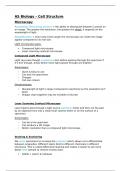Summary
Summary Cell Structure
- Module
- Cell Structure
- Institution
- OCR
Hand-typed summary notes of Cell Structure OCR-A Level Biology Unit 2. Very clear and efficient, providing you with all the key points you need to ace your exam. I achieved an A* in Biology, using these notes! Begins with details on microscopy and moves onto the ultrastructure of cells, before f...
[Show more]



